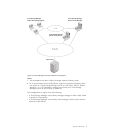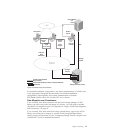v Cluster environment. See the Redbook IBM Tivoli Storage Manager in a Clustered
Environment for details on configuring the storage agent in an HACMP
™
environment.
ACSLS, SCSI and 349X Tape Library Sharing
When Tivoli Storage Manager servers share an ACSLS, SCSI tape, or 349X storage
device using a library manager and library clients, one server, the library manager,
owns and controls the tape library device. The library manager operations include
checking volumes into and out of the library, labeling volumes, mounting and
dismounting volumes, auditing volumes, and tracking an inventory of library
contents. The storage agents, along with other Tivoli Storage Manager servers that
share this library, are considered library clients. As a library client, the storage agent
is able to store data and request drives, tapes, and volumes.
When the Tivoli Storage Manager server (data manager server) is also the library
manager for the devices where data is stored by the storage agent, then the storage
agent communicates requests to this Tivoli Storage Manager server. When the
Tivoli Storage Manager server (data manager server) is another library client, then
the storage agent communicates requests for itself or the metadata server directly
to the library manager.
Note that when using a shared ACSLS library, the library manager must be a Tivoli
Storage Manager server on AIX, Solaris, or Windows.
A library client requests shared library resources, such as drives or media, from the
library manager, but uses the resources independently. The library manager
coordinates the access to these resources. Data moves over the SAN between the
storage device and either the library manager or the library client. Either the
library manager or any library client can manage the LAN-free movement of client
data as long as the client system includes a storage agent.
In this library-sharing environment, the most important relationship is the one
between the server and the storage agent. The server, working in conjunction with
the storage agent, manages the storage hierarchy. The server could be a library
client or library manager, and it is responsible for:
v Migrations
v Expiration of files based on policy information
v Reclamation of free space on volumes and consolidation of the volumes
v Disaster recovery
The
storage agent contributes information to the storage hierarchy through various
operations, but this role is independent of the library sharing role.
The library manager and library client configurations are represented in Figure 3
on page 7 and Figure 4 on page 8.
6 IBM Tivoli Storage Manager for SAN for AIX: Storage Agent User’s Guide
|
|
|


















